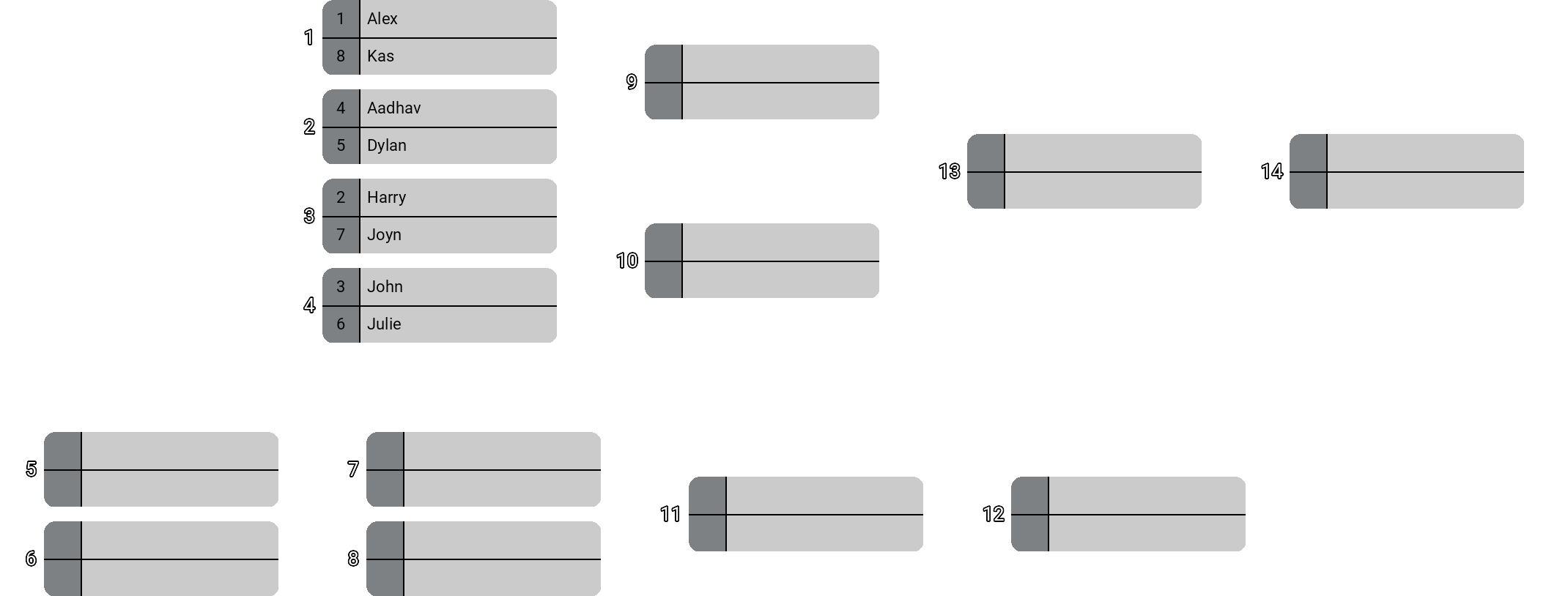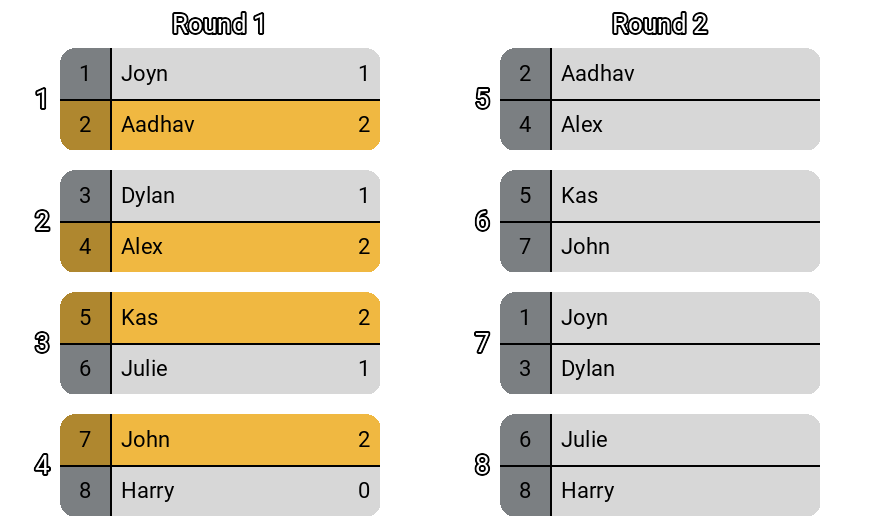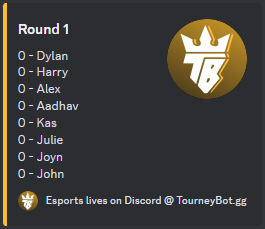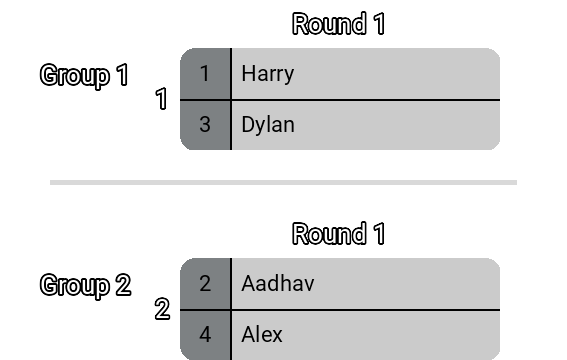Bracket Types
Tourney Bot supports a variety of bracket types. This blog post will walk you through each of the bracket types and what they mean.
Introductory Terms and Notes
Throughout this blog post, we will use a few terms that may be unfamiliar to you. This section will define those terms.
- Participant: A participant is a single competitor in a tournament. A participant can be a single person, or a team of people.
- Best of: A best of is the number of game matches that will be played in a single tournament match.
- For example, in a best of 3, the first participant to win 2 matches will win the match as it is not possible for the other participant to win enough to tie or win the match with only one remaining game match left in the tournament match.
- Match: A match is a single game between two opposing competitors. In a match, one participant will win and one participant will lose. In some cases, a match may end in a draw, but this is rare.
- Round: A round is a collection of matches. In a round, every participant will play a match. In some cases, a round may have a bye, which means that a participant will not play a match in that round and will still be able to advance to the next round.
- Bracket: A bracket is a collection of rounds. In a bracket, every participant will play a match in every round until the bracket is complete.
Different Types of Bracket Finals
Bracket finals are best defined when they are viewed in reference to the final round of the tournament, and worked backwards.
- Finals: The final round of a tournament is called the finals and consists of only 1 match between the final 2 competitors.
- Semi-Finals: The round before the final round is the semi-finals and consists of 2 matches between the final 4 competitors.
- Quarter-Finals: The round before the semi-finals is the quarter-finals and consists of 4 matches between the final 8 competitors.
- Round of 16: The round before the quarter-finals is the round of 16 and consists of 8 matches between the final 16 competitors.
- Round of 32: The round before the round of 16 is the round of 32 and consists of 16 matches between the final 32 competitors.
- Et cetera...
Bracket Types
Single Elimination
This tournament type goes by a few names: Single Elimination, Knockout, sudden-death, and likely more. However, through Tourney Bot and all of our documentation, we will refer to it as Single Elimination.
Single Elimination tournaments are effectively the simplest type of bracket that exists in the tournament world. The the winner of each match will move on to the next round until they make it to the finals. However, the loser of each match is eliminated from the tournament. This process of elimination continues until two participants remain who will then compete against each other in the finals. The finals are often played as a higher best of count than the rest of the tournament to ensure that the winner of the finals, and thus the tournament, did not just have a lucky break.
This is what your Single Elimination bracket will look like:

Double Elimination
Double Elimination tournaments are a bit more complex than single elimination but generally hold the same flow until the Grand Finals. Double Elimination tournaments offer all participants 2 "lives" during the tournament. You lose a life when you lose a matchup, and when you lose both lives you are eliminated from the tournament. This gives everyone an opportunity to lose a single match but not be knocked out of the tournament entirely. Thus, giving each participant an opportunity to bounce back from their first loss, which can help create a more competitive environment for your participants.
Here's how it works:
-
Winners Bracket: Each tournament begins with a winners bracket, and this is where each participant will start, even if byes exist. The winners bracket is effectively a single elimination tournament but with a unique twist. Each match will continue to have a winner and a loser and the winner will advance to the next round like normal. However, the loser will not be eliminated from the tournament. But will instead, be sent to the losers bracket where they will have their final chance to continue in the tournament.
-
Losers Bracket: The losers bracket has a closer resemblance to a single elimination tournament because if a participant loses in the losers bracket, they are eliminated from the tournament. Winners in the losers bracket will also advance to the next round like normal. Eventually, the last standing winner of the losers bracket will be matched up against the winner of the winners bracket where they will compete in the Grand Finals.
-
Grand Finals: Now that our Double Elimination tournament has 2 winners, one from the winners bracket and the other from the losers bracket, we need to determine who is the overall winner of the tournament. That's where the Grand Finals comes into play. The match scoring for the Grand Finals is a little bit different than normal since it gives a match advantage to the winner of the winners bracket. This means that if the winner of the winners bracket wins the first match of the Grand Finals, they will be declared the overall winner of the tournament. However, if they lose that first match, a second match will need to be played since the winner of the winners bracket effectively just lost their first "life" of the tournament. Now, either participant who wins the second match will be declared the overall winner of the tournament.
This is what your Double Elimination bracket will look like:

Round Robin
Round Robin tournaments are considered the fairest and most effective way to determine the best participant(s) out of a group. Round Robin tournaments accomplish this by matching every participant against every other participant in the tournament. This method makes it so that each participant has an equal number of matches and opportunity against everyone.
-
Scoring: Instead of matches only being scored as a win, loss, or tie, points are for awarded to participants for their wins and ties. These points are then used to determine the final standings.
- For example, a win might be worth 3 points, a tie 1 point, and a loss 0 points.
-
Result: Round Robin tournaments can have various rules for determining the overall winner. However, the participant with the most points at the end of all matches is usually declared the winner without contest. But, in the event of ties, tiebreakers like head-to-head results, goal difference, or other criteria can be used.
This is what your Round Robin bracket will look like:

Round Robin tournaments can get very out of hand very quickly. For example, a 12 participant Round Robin tournament would require 66 matches to be played. Please keep this in mind when setting your player cap for Round Robin tournaments.
The formula for calculating the number of matches in a Round Robin tournament is (n * (n - 1)) / 2 where n is the number of participants.
Swiss
Swiss tournaments are a popular choice for competitive events and as an alternative to Round Robin. During a Swiss tournament, participants will play a set number of rounds against other participants. The number of rounds is usually determined by the number of participants in the tournament. For example, a 16 participant Swiss tournament will usually have 4 rounds.
-
Performance: Participant's performances are based off of their overall score. This score is determined by their own number of wins, losses, ties but also the number of wins, losses, and ties of their opponents.
-
Pairings: In each round, participants are paired based on their current performance. Players with similar records face off against each other.
-
Scoring: Points are awarded for wins, ties, or other criteria. A common scoring system is 3 points for a win, 1 point for a tie, and 0 points for a loss.
-
Pairing Algorithm: Our Swiss system avoids pairing participants against each other more than once. This is done by using a pairing algorithm that keeps track of which participants have played against each other and which participants have not. This algorithm is also used to determine which participants will receive byes in the event of an odd number of participants.
-
Results: After the set number of rounds have been played, the participant with the highest score is declared the winner. In the event of a tie, Tourney Bot utilizes 5 different tiebreakers to determine the winner.
This is what your Swiss bracket will look like:

Tiebreakers
The following are tiebreakers that Tourney Bot uses to determine the winner of a Swiss tournament. Each tiebreaker is used in order until a winner is determined.
- 1. Win Percentage
- Participant Wins / Games Played
- Higher win percentage wins
- 2. Points
- Whoever has the most points wins
- 3. Opponent Win Percentage (OW%)
- Average of all opponent win percentages
- Whoever has the highest OW% wins
- 4. Head-to-Head
- See if the players played each other before, whoever won that match wins
- 5. Jake Break
- Sum of the participants opponents' scores for matches that they won.
- Whoever has the highest Jake Break points wins
FFA/Race
FFA/Race bracket types are perfect for games that host a single match but with multiple competitors. These types of brackets are often used for games like Mario Kart, Super Smash Bros, Fortnite, Apex Legends, and so on.
- Best Of: For FFA/Race tournaments, each round will consist of a single match against all players.
- Scoring: Points will be recorded via 'Sports Mode', which allows you to enter in a score between -999 and 999 for each participant. A participant's score usually comes from their score in the game itself, but what metric you use is up to you. (ie. Kills, Points, Lap Time, etc.)
- Rounds: Each round is a single match between all participants. The number of rounds is determined by the number of matches you want to play. For example, if you want to play 3 matches, you will need to create 3 rounds.
- The round count is set to 3 by default.
FFA/Race brackets on Tourney Bot do not actually use any type of bracket. Instead they generate round by round score tables that are used to determine the overall winner of the tournament.
This is what your FFA/Race "bracket" will look like:

Group Stage
Group Stage tournaments attempt to reduce the clutter and complexity of otherwise several Round Robin tournaments. Group Stage tournaments accomplish this by splitting participants into groups and then running a Round Robin tournament for each group. This allows for a more manageable number of matches to be played while still giving each participant an equal opportunity to compete against everyone. After the Round Robin tournaments are complete, the top participants from each group can then be seeded into an elimination bracket of your choice.
This is what your Group Stage bracket will look like:

Conclusion
We hope that this blog post has helped you understand the different types of brackets that Tourney Bot supports. If you have any questions, please feel free to reach out to us on our Discord Server! Good luck with your tournaments!
